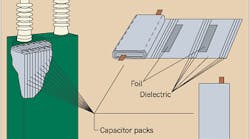Last month's column explained that AC current flowing through an inductance reaches its peak amplitude after the voltage. Lagging current is characteristic of an inductive circuit. Capacitive circuits, however, have a current that leads the voltage.
Power capacitors are made up of capacitor packs. The individual packs are stacked together and jumpered to form parallel or series units. Each pack comprises metallic plates, often made of aluminum foil, separated by a polypropylene dielectric. Paper is sometimes also used as a dielectric. These foil/polypropylene sandwiches are rolled up and enclosed in an oil-filled tank. Capacitors like this are commonly used for power factor correction and filtering on systems ranging from low-voltage through the highest transmission voltages.
Power capacitors aren't the only devices that exhibit capacitive properties. Equipment bushings, insulated cable, and even open-wire transmission and distribution lines all appear as capacitors connected from line to ground. The capacitance values of these devices tend to be larger at higher operating voltages.
How does a capacitor work?
Capacitors store energy in the electric field established in their dielectrics similar to the way inductors store energy in their magnetic fields. The electric field is produced by electric charge on the capacitor plates. Filters use capacitors to “fill in” gaps in waveforms by giving up stored charge to the electric circuit, or to “shave off” spikes in waveforms by absorbing the excess energy and storing it in the electric field.
Capacitors connected from line to neutral provide reactive power to an AC circuit, which is measured in volt-amperes reactive (VARs). For a given value of capacitance, more VARs are supplied as the operating voltage is increased. Since they're a source of reactive power, capacitors can furnish the VARs consumed by inductive loads. Since the VARs provided by the capacitor don't have to be supplied from the system, the power factor of the system rises due to the connected capacitor. This is known as power factor correction, and will be covered in next month's column.
Resonance.
All power system components have electrical resistance, and most exhibit inductive characteristics. Adding capacitors to the power system introduces the possibility of resonance. If the reactance of the inductive and capacitive parts of a circuit are equal, energy will oscillate between the inductance and the capacitance, producing high voltages that could exceed the capability of the system's insulation.
The reactance of an inductor and a capacitor is a function of frequency. A circuit containing resistance, inductance, and capacitance is resonant at one specific frequency. If that frequency is close to the fundamental frequency (60 Hz in the United States) or an integer multiple of that operating frequency, serious problems will result. When resonance occurs, the inductance or capacitance values must be adjusted so the resonant frequency isn't close to the fundamental frequency or its harmonics — multiples of 60, such as 120, 180, or 240.




